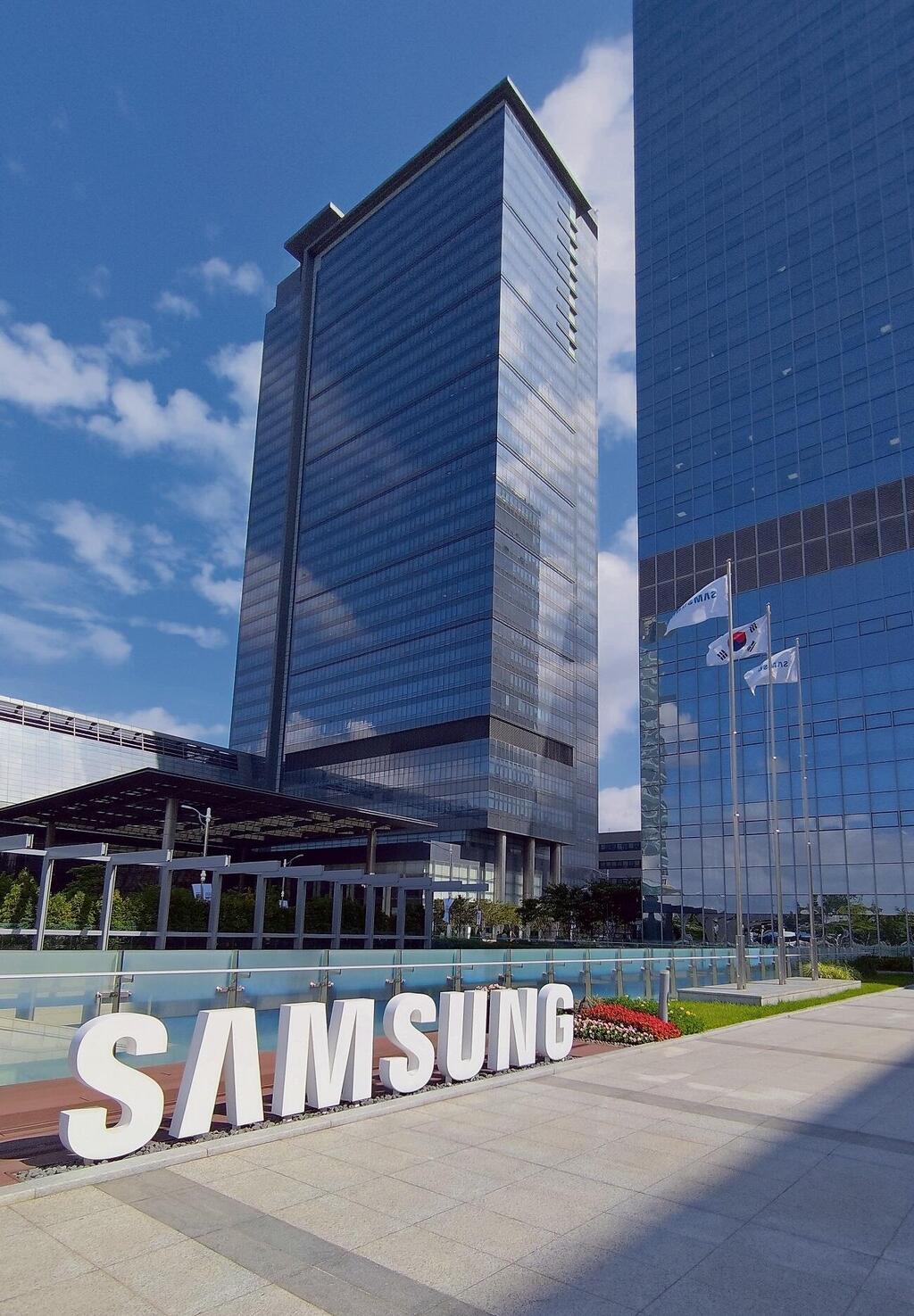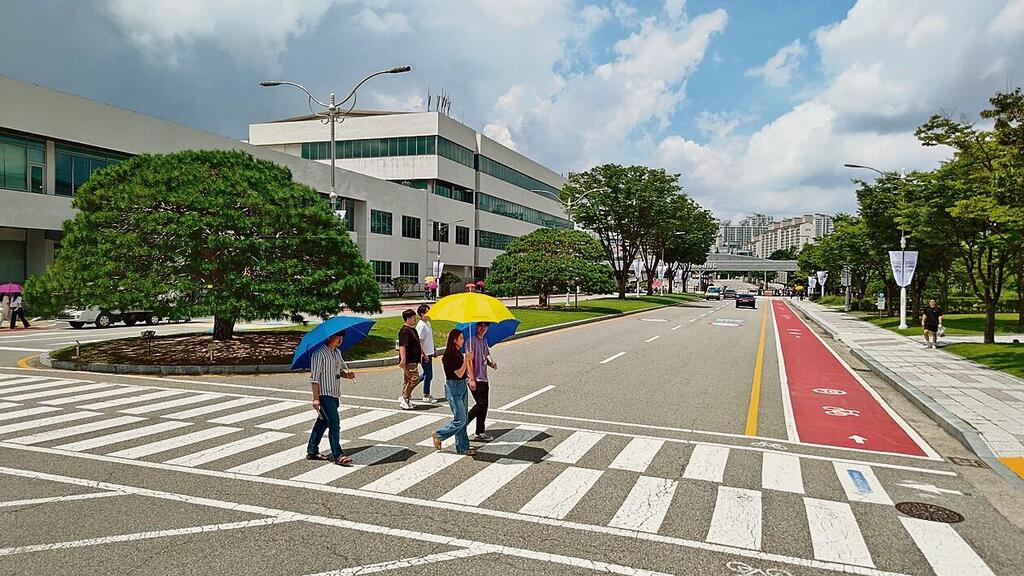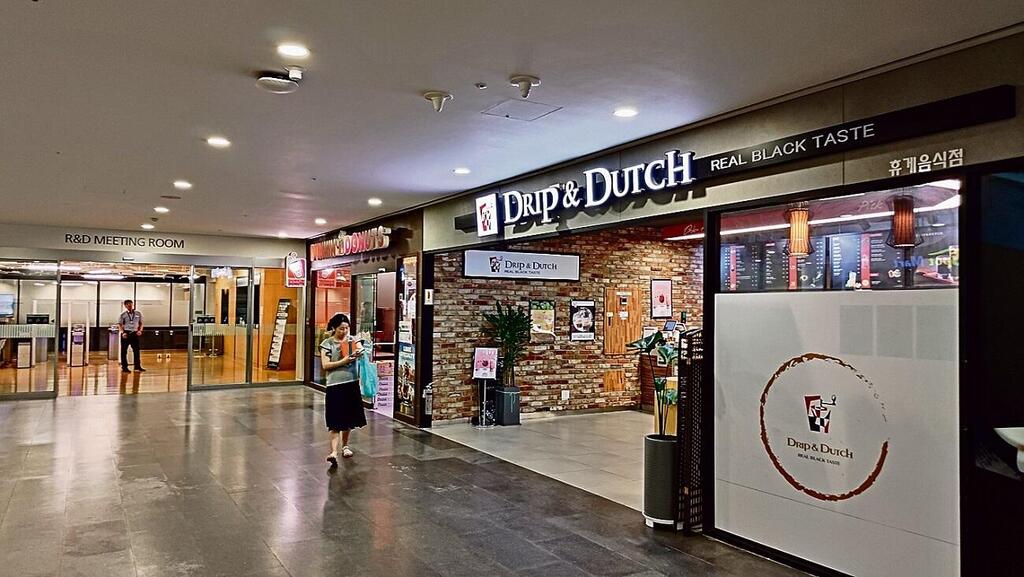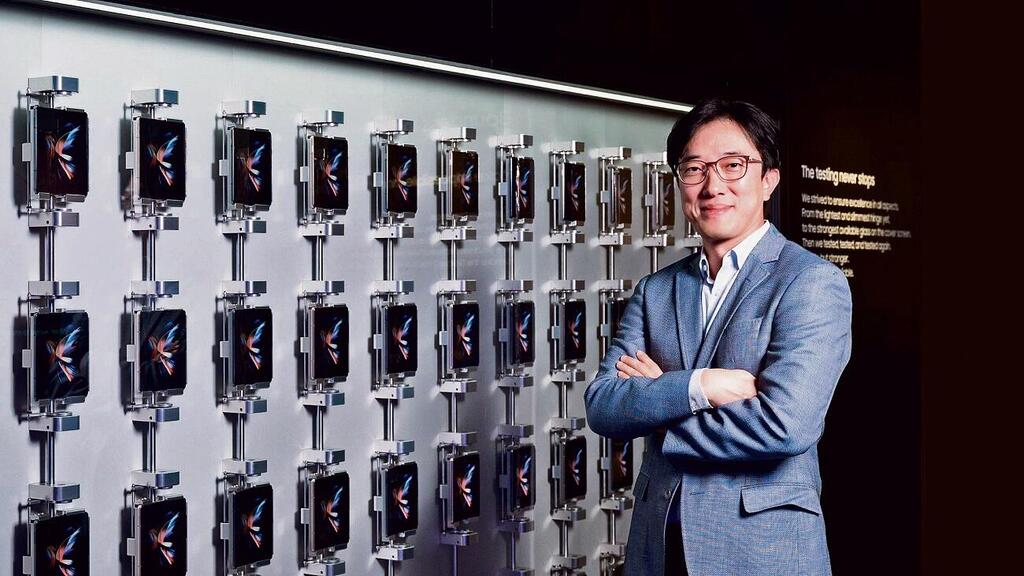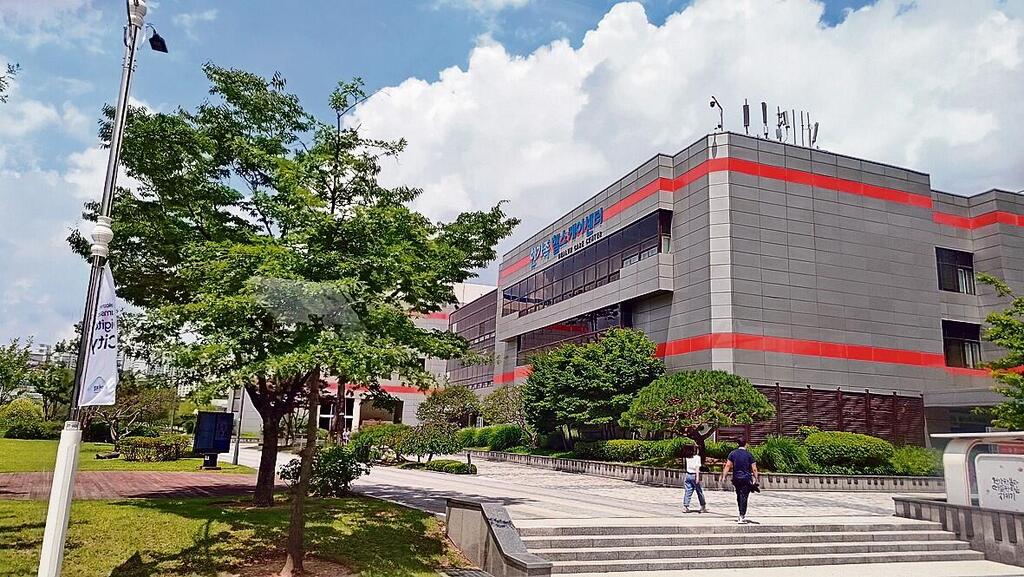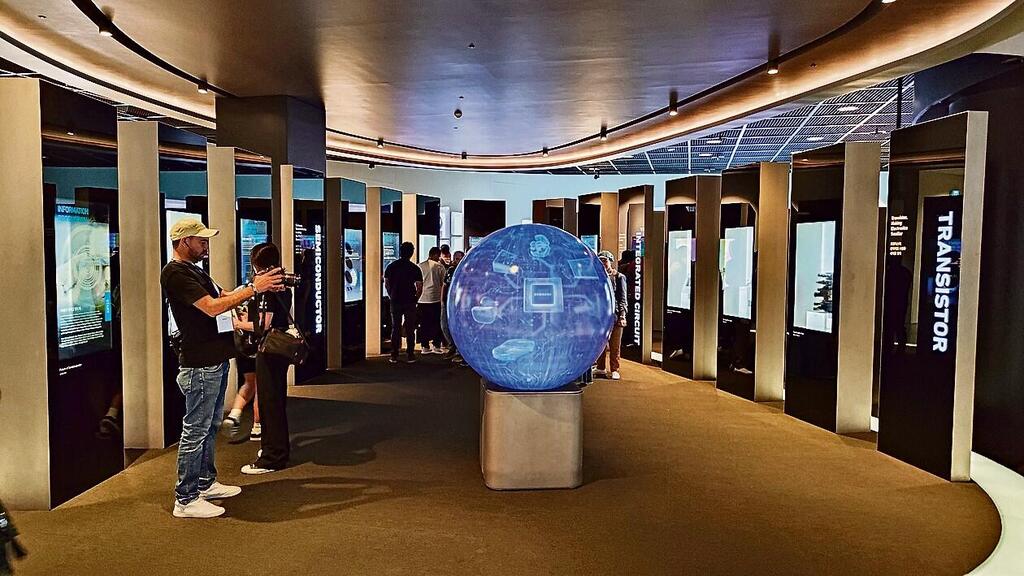July and August are not the best time to visit South Korea. While the temperature is similar to that of Israel, sudden rain showers can be quite a nuisance.
Read more:
On the other hand, this is the moment when thousands of colorful umbrellas spanning the spectrum of the rainbow suddenly cover the streets of Samsung's Digital City. At the entrances of the massive buildings, 10,000 umbrellas await the workers, and they return them after hopping to the nearby supermarket, clinic, swimming pool, gym or daycare center; all part of the gigantic campus, the main nerve center of one of the world's largest technology companies.
Last week, Digital City was dressed for a holiday, and very unusually opened its doors to journalists. This is the inner sanctum of Samsung, and the timing is not accidental: it aligns with the launch of the company's two new folding smartphones, which were developed here, and the extraordinary importance the company attaches to their promotion, especially in a period when global cell phone sales are at a low.
Digital City in Suwon, the headquarters of Samsung's electronics division, is located about 20 miles south of the capital, Seoul. It spans 7.75 million square feet and houses 37,000 employees — over half of the division's research and development workforce, who are scattered across another 40 centers worldwide, including in Israel. This is the largest and most significant campus of the Korean giant, which employs a total of around 300,000 people.
It's important to note that this is just a part of a conglomerate that spans a wide range of sectors in Korea: real estate, insurance, hotels, credit cards, financial services, shipbuilding, fashion, medicine, economic research, and more.
Samsung Electronics is considered one of the top 20 largest companies in the world and is traded at a market value of hundreds of billions of dollars. In Digital City, it centralizes the development of its most popular products: cell phones, computers, televisions, tablets, smartwatches, and more.
This is also where President and Head of Mobile eXperience Business at Samsung Electronics TM Roh and the executives have their offices. South Korea owes much to this place, which has dramatically contributed to the economic boom it enjoys today.
Barista course
Digital City is actually part of what is called Samsung Digital Valley in Korea. The company holds two other centers in the area: in neighboring Yongin, the headquarters of Samsung SDI, which develops lithium-ion batteries for devices and electric cars and employs another 13,000 people, and in Hwaseong, 10,000 additional employees develop the company's advanced chips. Since the three municipalities struggled to provide the appropriate services for such a creative and innovative environment, Samsung took on the task itself.
Thus, although it is part of the city of Suwon - an ancient walled city, a UNESCO World Heritage site - Digital City operates entirely independently: it consists of five main office towers up to 40 stories high, each dedicated to a different field of activity. These are connected by a large green park, appropriately named Central Park, and are surrounded by around 130 smaller buildings. Among them are a modern, advanced hospital, three kindergartens, 15 coffee houses, and 13 restaurants - some of which are well-known international brands - training and learning centers, a rescue and fire station with 31 firefighters and paramedics and even a small hotel for visiting researchers.
All the workers - doctors, nursery teachers, firefighters - are Samsung employees. Within Central Park, 40 small halls have been erected for club activities. Any group of 5 employees can start a club, and it turns out that there are 858 such clubs in Digital City; these activities range across the bizarre spectrum - from table tennis, painting, and Japanese flower arranging to barista courses for coffee bean roasting.
On Family Day, the entire Digital City turns into a large amusement park for the employees' families and local residents. All services, by the way, are provided free of charge to employees, their partners, and children. Samsung also covers all necessary insurances for everyone.
The newest and central tower in the complex, R5, built in 2013, is the birthplace of all the products we know from the Galaxy series — cell phones, tablets, watches. All were designed here from scratch, both software and hardware together. It houses product development and testing labs, advanced video and sound studios, 1,000 meeting rooms, and an auditorium for 700 people.
A CNN reporter, who was exclusively hosted in the building four years ago, witnessed experiments with blood pressure and heart rate sensors, which have since been incorporated into the company's watches, and a device for monitoring blood sugar levels, which has not yet been launched.
Last week, on the eve of the launch of the new Galaxy Z Fold 5 and Flip 5, a giant screen at the entrance of the building displayed a huge clock with a countdown.
On the lower floor, we passed through the restaurant corridor, peering into the Olympic swimming pool and the enormous gym adjacent to it. On average, 1,600 people work out there every day.
On the upper floors, on the other hand, prototype devices from new production lines undergo rigorous testing to ensure they live up to their promises: they are submerged in deep water, thrown from heights, closed and opened again 200,000 times, crushed under extreme physical pressure and ruthlessly blasted with water cannons.
Dr. Won Joy Choi, the head of Samsung's Mobile R&D Center, is responsible for developing the company's flagship devices. Choi, a Stanford graduate with both a master's and Ph.D. in electrical engineering, shares with us the Herculean behind-the-scenes of what seems like a slow evolution of devices from year to year.
"Slow? From the Fold 2 to the new Fold 5," he says, "we managed to reduce the device's weight by 29 grams and 'slim it down' by 21%. Compared to the first Flip, we managed to increase the external screen tenfold and reduce the thickness by 13% on the new model. In other words, over the years, we have managed to pack more components into a smaller area. Technologically, these are huge achievements, resulting from extensive research, new materials development, and dealing with complex engineering challenges.
In Fold 3, for instance, we needed to develop a new metal to make it waterproof. We did the same to reduce the S pen by 40% forThe older tower, R4, is the fortress of the television screen and display technology developers, while R3 houses the communication technology experts.
Throughout the campus, connected by four-lane roads, are ten basketball courts, three soccer fields, two baseball diamonds and four badminton courts. A transport system of 500 buses moves workers around the campus, and for senior management, there are Samsung helicopters on standby, ready to take off at any moment.
There's also a small building — a three-story family home — designed and built from scratch to demonstrate smart home devices: from the electric car charging in the yard, through the adjustable bed, the rising screen and automatic curtains in the bedroom, to the perfect synchronization between the cellphone, the laptop and the desktop in the workroom.
In recent years, within the Digital City, a separate internal area called the 5G City has been established, for the demonstration and testing of fifth-generation cellular technologies. Samsung — apart from being the world's largest manufacturer of cellular devices — also competes with Nokia, Ericsson and Huawei in the establishment of cellular communication networks. This area includes a small 5G Stadium dotted with fifth-generation antennas using the fast MIMO technology; a "Connectivity Center" that showcases an urban area studded with cameras and sensors connected through 5G and other wireless networks; and a 5G Kiosk that displays thrilling download speeds for video services, software updates for vehicles, and more.
Among other things, several large anechoic chambers were set up, used for analyzing and testing the performance of fifth-generation antennas. To give a sense of scale, the latest chamber built in the Digital City is the size of a basketball court.
Fold 4. People don't know this, but it took 9 solid years of research before launching our first foldable device."
President Tae-moon Roh, also an engineer by training, took up his role just over a year ago. "Throughout my career as an engineer," he says, "I have learned that the most impressive designs are always intertwined with technological innovation, and this new role allows me to delve into the depth of this synergy between design, engineering planning, and R&D, a combination that can create truly transformative experiences."
For history's sake
Among all the day-to-day development activities in Digital City, Samsung takes particular pride in the C LAB, a huge, light-flooded workspace that serves as a stage for developing out-of-the-box ideas; it's a sort of internal incubator for startups. Of course, Samsung didn't invent the concept: it's common at Apple, Microsoft, Google — and at any giant company that can afford to let its employees dedicate significant portions of their time to developing ideas, only a minority of which will become a working product.
Any employee in Digital City can submit an idea and apply to join a project, regardless of their role. The 30-40 employees whose ideas are accepted are entitled to take a year off from their regular duties and are invited to the lab, where they are provided with all the equipment and services they need to develop their idea.
Samsung even allows them, at the end of the year, to embark on their journey with a prototype in an independent startup company, with seed funding, while it remains a minor partner. The record so far is impressive: out of 390 projects to date, 93 have been moved to further development within Samsung and 40 have become independent startups.
As part of the concern in the tech world about the relatively slow adoption of smart home devices, Samsung launched another initiative four months ago called Experience Home. It collaborates with other manufacturers on research designed to enable all smart home devices to communicate with each other — no matter from which sector or company they come.
According to President TM Roh, "We believe that when we work together with other industry leaders, we can advance not only our product environment but the entire smart home field."
In the late 1960s, the South Korean government made a decision: to transform the country into a global technology powerhouse. Until then, its technology products were considered inferior, even to those from China, let alone Japan or Germany.
This was not just a proclamation – actions followed the decision: substantial budget allocations were made to education, research and development, funding for technology studies in academia, and support for the establishment of new technology companies.
The response was so rapid that by the 1980s, Korea had become a leading manufacturer of home electronics, and later a leader in electronic components, computer, and mobile devices. Samsung Electronics, established in Suwon in 1969, owes its leap forward to the Korean government – to the Electronic Industry Promotion Act and to the fund established in its wake. Originally, before the establishment of Digital City, it manufactured black-and-white televisions in Suwon.
Today, as South Korea is one of the most developed countries in the world and Samsung is one of its standout symbols of success, the company can already audaciously claim a part in the impressive technological achievements of humanity as a whole.
Every weekend, it opens its beautiful Innovation Museum in Digital City to the Korean public. Across three well-designed floors and using the latest technology, it showcases the history of technology in brief — from the invention of electricity and the telephone, the radio and the first computer processors, to the breakthroughs that led to flat-screen TVs, foldable smartphones and even the smart refrigerators of today.
To its credit, it also pays tribute to products developed by others — for example, Motorola's first cellular phone, Sony's pioneering screens, and more — but it is clear that on the floor dedicated to current technology, only its own devices star. And what about a small company named Apple, didn't it contribute something in the field? Well, even Samsung understands that history is determined by those who write it.
Marketing blitz
Samsung has invested considerable resources in their two new foldable smartphones, the Galaxy Z Fold 5 and Galaxy Z Flip5, the presale of which began this week. In addition to the billions of dollars and countless man-hours spent over recent years developing the foldable screen technology, which is only now reaching maturity, the company is sparing no expense in their aggressive marketing.
In an era where overall cell phone sales are declining significantly worldwide and the differences between them are becoming blurred, foldables stand out as a unique product. They offer added value that differentiates them from the rest, underscoring Samsung's technological superiority.
Granted, almost all competitors - including Google - have already launched their own variations on the theme, but Samsung, a pioneer in the field, has already had enough time to fail, rise again and accumulate the necessary expertise and experience to surpass them in terms of performance and reliability. But Samsung knows that this gap will close soon, and hence it's time to step on the gas. The new Fold and Flip, officially launching in Israel on August 17, are significantly improved over their predecessors.
Considerable effort was invested in overcoming tough technological limitations: eliminating the space previously created in the folding area between the top and bottom, a full external screen on the Flip when closed, full waterproofing, battery life improvements, screen protection against breakage and cracks and improving the smart hinge (which has been completely replaced with a new hinge). And of course - reducing thickness and weight.
Samsung hopes that the external screen on the Flip will make the difference: you can operate widgets and perform many actions without having to open the device at all. For example, messaging on WhatsApp, watching Netflix movies and YouTube videos, navigating with Google Maps, taking high-quality selfies, displaying information such as weather and stocks, accessing WiFi or Bluetooth settings and more.
One issue that has yet to be resolved is the price. The Fold, priced at NIS 8,000 (over $2,100), is by definition a luxury product, targeted at the upper market segment (in Israel, incidentally, it did not achieve spectacular success); but Samsung dreams of turning the Flip into a hit among teenagers—a difficult task when its price approaches NIS 4,000 ($1,100). On the other hand, the company profits more from expensive devices: if it can convince us that the purchase is worthwhile and "stretch" the circle of buyers—the profits will naturally follow.



